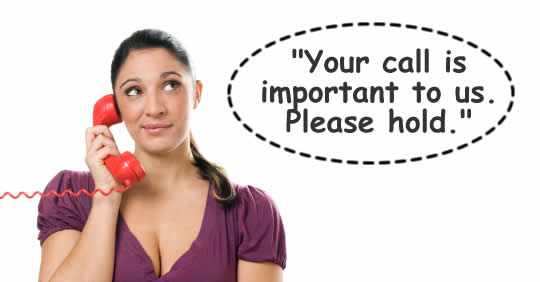If Your Customers Have to Wait…
In years of running a direct marketing firm that included a small call center, my objective was to eliminate, or at least minimize, waiting time for phone customers. We knew (from those times when we didn’t have enough staff in place) that the longer callers waited to speak to a representative, the higher the probability was that they would abandon the call. And, if they hung up, they might never call back.
Zappos, legendary for customer service, strives to answer 80% of its calls within 20 seconds.
While one can’t argue with delivering great service and minimizing customer frustration, there’s a way that short waits can be used to good advantage. What do your customers hear if they have to wait for a representative? Elevator music? Recorded ads? Mindless statements telling the customer how important her call is? (Important, no doubt, but not important enough to answer right away!) Instead of those common and boring solutions, try something a little different: building in “social proof” messaging might actually keep callers on the line and, when the call is answered, boost conversion rates.
A classic story from direct marketing (I ran across it most recently in Guy Kawasaki’s Enchantment) is that of writer Colleen Szot’s tweaking of an infomercial for exercise equipment. Szot changed the ubiquitous “Operators are waiting, please call now to “If operators are busy, please call again.” This seemingly trivial change caused sales to skyrocket. In Yes! 50 Scientifically Proven Ways to Be Persuasive, Robert Cialdini and his co-authors attribute the jump to “social proof.” In essence, the implication is that lots of other people may be buying the product and that the operators may be swamped.
While this example was from an infomercial, where else could you improve sales with messaging exploiting social proof? Here’s one possibility:
Current Hold Message: “We are experiencing higher than expected call volume. Thanks for holding.”
Better Hold Message: “Due to high order volume during our holiday sale, our wait times are a little longer than usual. Thanks for holding.”
An interesting question is whether there is an optimal hold time to go with this message. I think regardless of how well crafted the copy is, long hold times will result in lost calls and lost orders. A very short hold time – perhaps just long enough to deliver the message – is still likely best. The customer will feel lucky that his call was answered so promptly under the circumstances.
Naturally, this kind of message will wear out its welcome over time. Regular rotation is a must. And any automated attendant messages must be consistent with the overall marketing story and whatever promotion is generating the inbound calls.
The best part about this small step is that it costs nothing. What’s on YOUR hold message?

